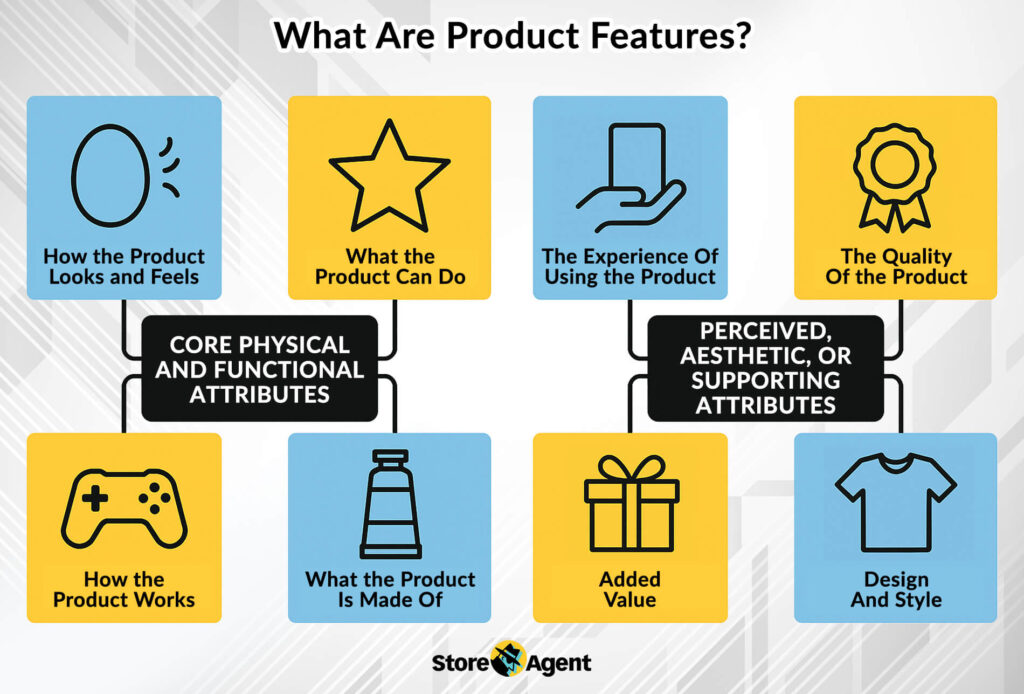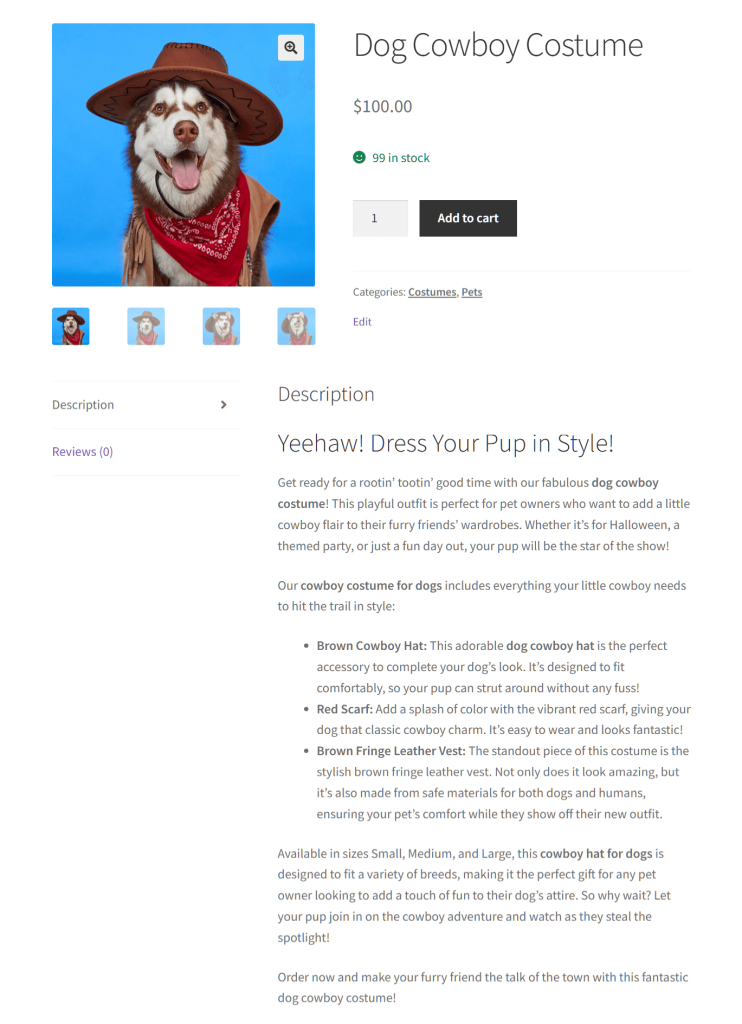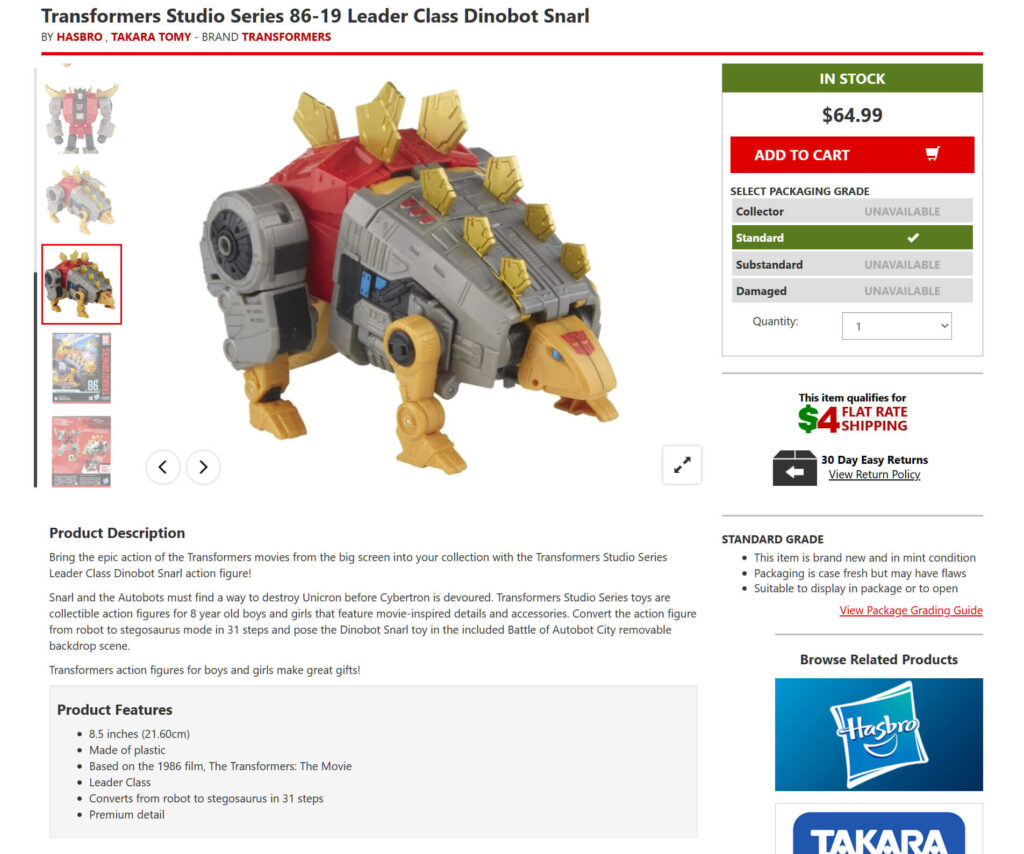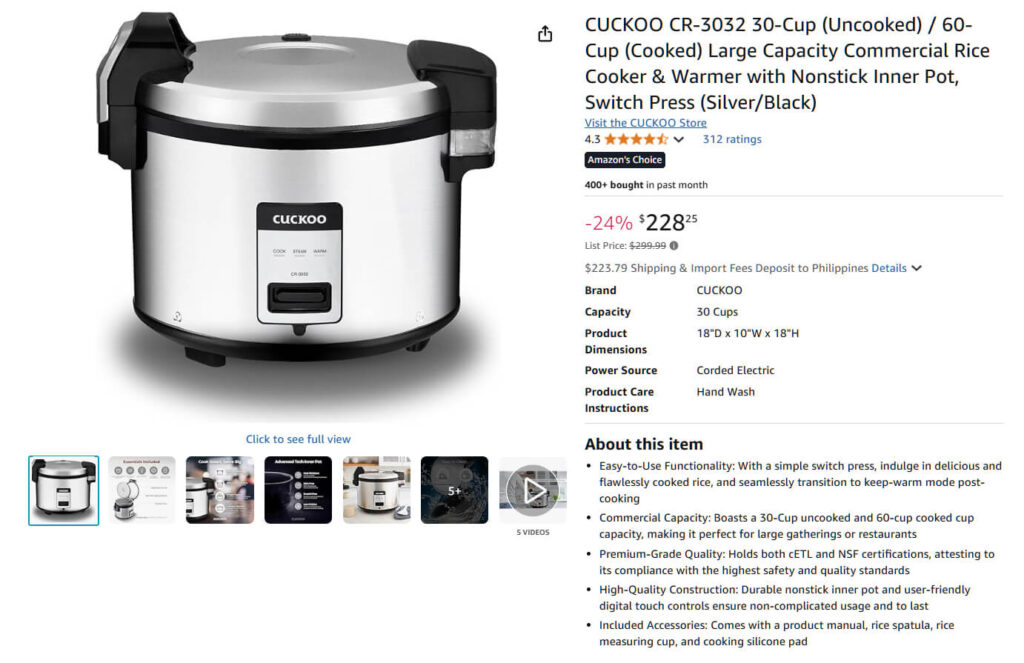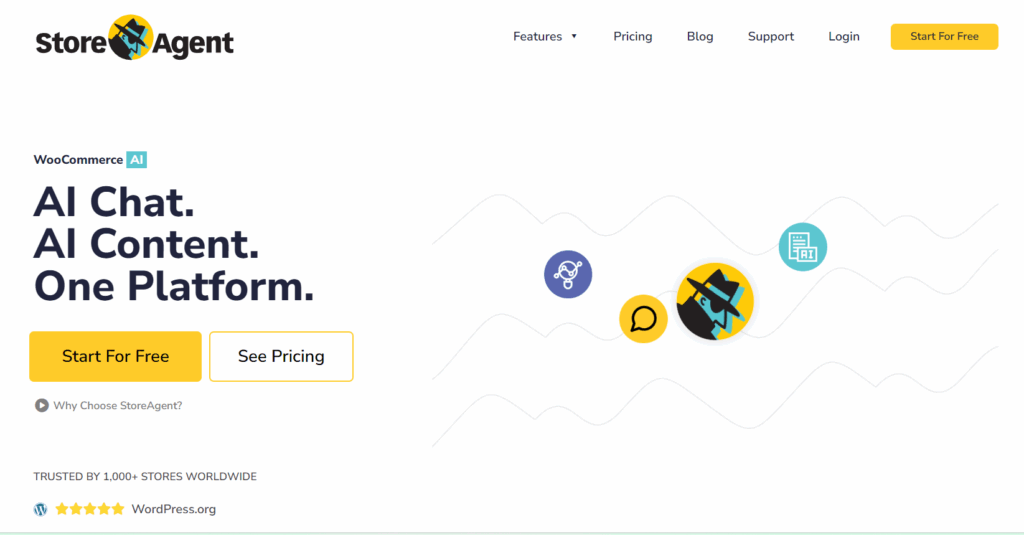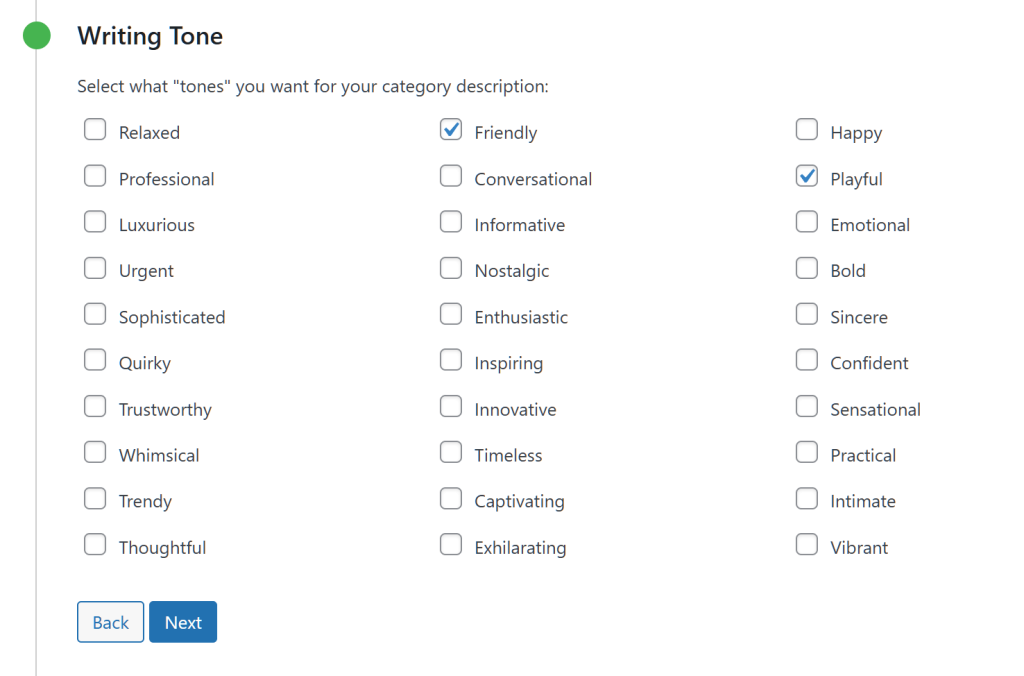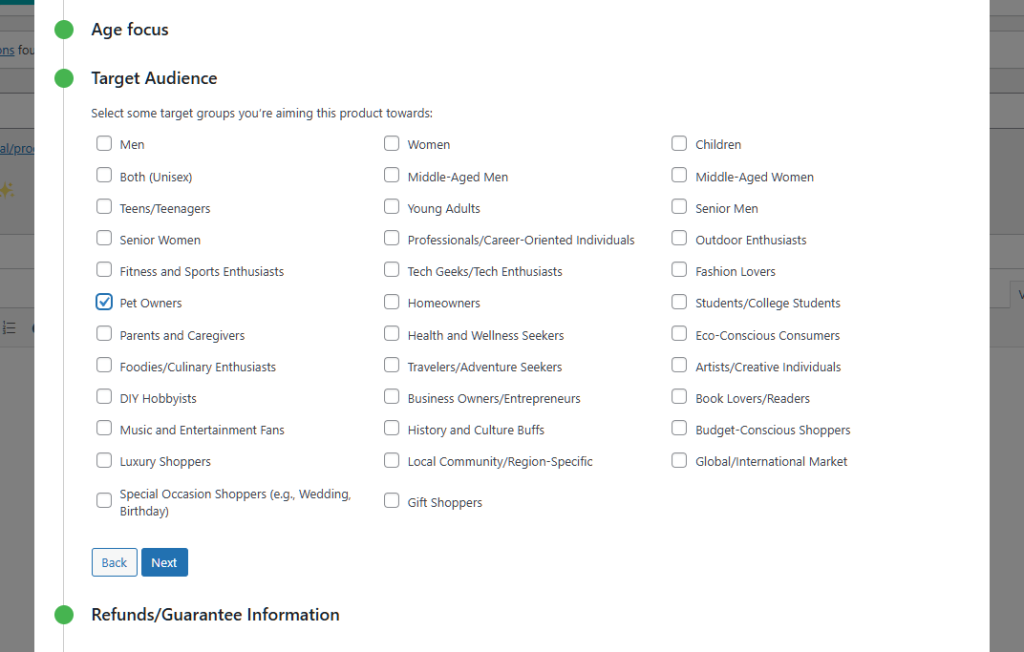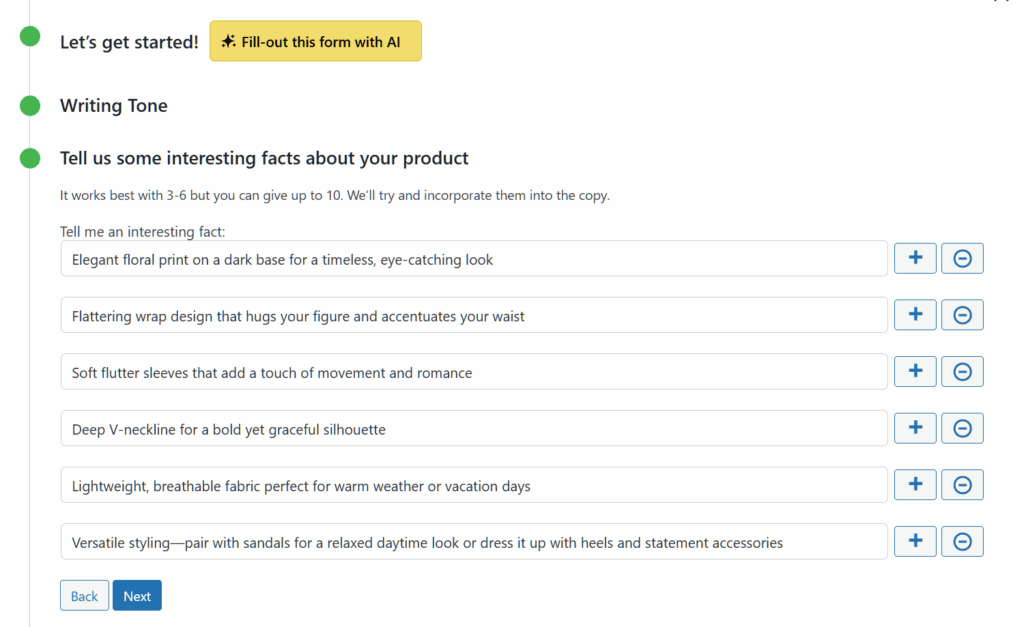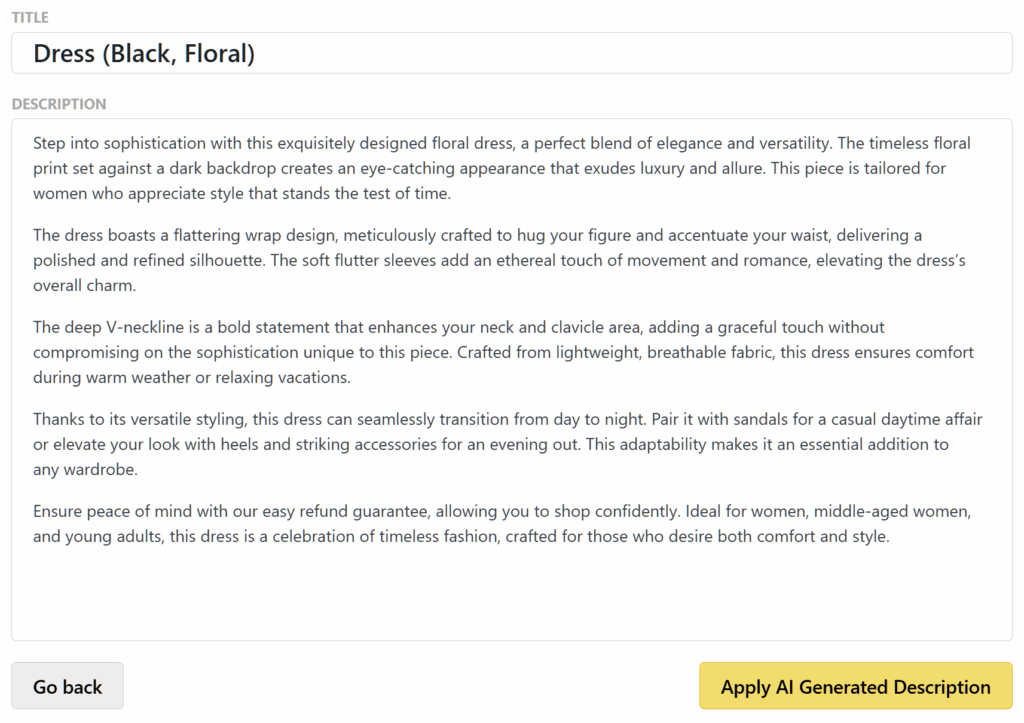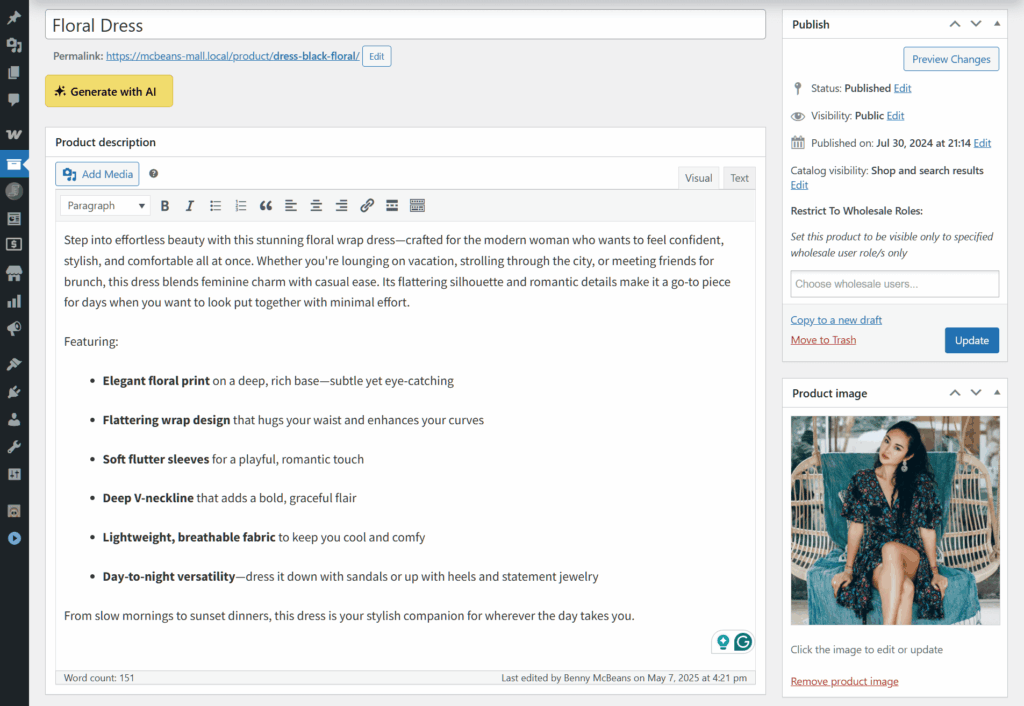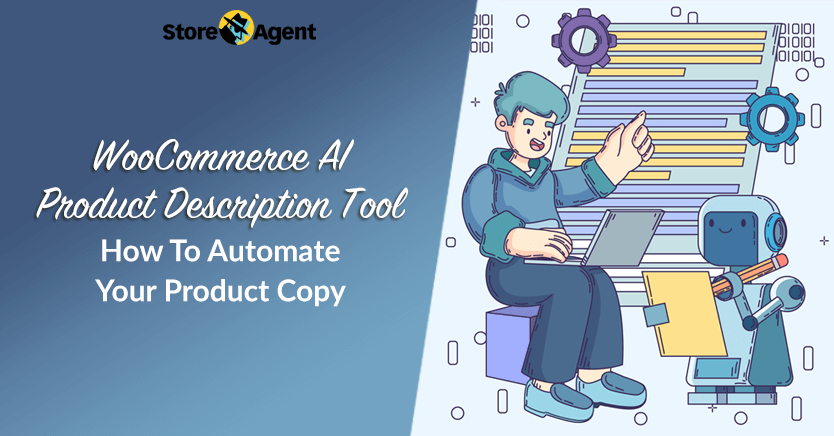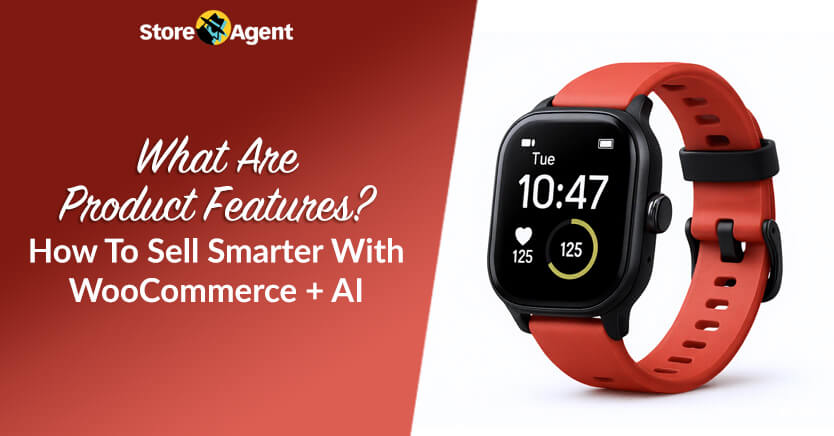
What are product features? In simple terms, they’re what give a product its identity.
In ecommerce, product features help shoppers understand what a product is all about. However, they do more than just describe; they also guide people toward the right choice by easing doubts or answering questions. They can even spark a sale.
In this article, we’ll cover what product features are, how to use them to encourage clicks, and why they matter in product descriptions. You’ll also see how AI tools like StoreAgent make it quicker and easier to present these features in a way that encourages people to buy.
So let’s get cracking!
Table Of Contents
- I. What Are Product Features?
- II. Why Product Features Matter In Ecommerce
- III. Types Of Product Features WooCommerce Sellers Should List
- IV. Tips For Writing Product Features That Sell
- V. How StoreAgent Helps Write Product Features With AI
- Conclusion
I. What Are Product Features?
The features of a product are the characteristics or attributes of a product that describe its physical qualities, capabilities, components, or functions.
In other words, they’re the details that explain what a product is and what it can do. They show what it’s made of, how it works, and what makes it different from others.
Let’s take a closer look at what product features describe.
Core physical and functional attributes
These are the features built into the product itself:
- How the product looks and feels: These include physical traits like size, weight, shape, color, and texture. They help people picture the product and decide if it suits their needs or preferences.
- What the product can do: This refers to the product’s capabilities, or, in other words, its key tasks or powers. For example, a blender’s capability might be crushing ice or making smoothies.
- How the product works: These are the functions, or the actions the product performs to deliver its capabilities. For instance, a video game console might support wireless controllers, offer online multiplayer access, or let users stream games and media.
- What the product is made of: These are the product’s components or materials. For example, an oil paint set might include aluminum tubes filled with pigment and oil, along with a metal tin or wooden box for storage.
Perceived, aesthetic, or supporting attributes
These features shape how people experience and evaluate the product beyond its physical design:
- The experience of using the product: This covers things like easy setup, smooth onboarding, or helpful support that make the product easier or more pleasant to use.
- The quality of the product: Quality can refer to durability, performance, or even brand reputation. High-end products often promise better materials or craftsmanship.
- Added value: Extras like free accessories, bundled services, or generous return policies can make the product more attractive without changing its core.
- Design and style: Aesthetic details—like colors, patterns, or a distinctive look—can set a product apart, especially when function alone isn’t enough.
In short, product features tell people exactly what the item is, what it does, and what it’s made of.
Features vs benefits
Product features cover technical facts and visual details. However, they stay focused on the product itself, not the buyer’s feelings.
On the other hand, product benefits explain how a product improves someone’s life, like saving time, reducing stress, or solving a problem.
While benefits show the value to the buyer, features give the hard facts. Both work together to help shoppers understand and choose.
II. Why Product Features Matter In Ecommerce
Before we can discuss why product feature lists matter in ecommerce, we must first define what a product description is and its importance.
A product description is the text that explains what a product is, what it does, and why someone should buy it. It usually includes key facts, selling points, and helpful details to guide the shopper’s decision.
One of the most important parts of a product description is the product feature list.
These features aren’t just extra details. In fact, their main purpose is to help shoppers understand exactly what they’re getting. In a crowded store or marketplace, they can make all the difference.
🧠 Remember! Product features belong in every listing, whether it’s a fashion item or a power tool. They’re part of what helps shoppers know exactly what they’re buying.
With all that in mind, here are the main reasons product features matter in product descriptions and ecommerce:
1. Faster decision-making
From what we’ve seen, most shoppers don’t want to spend forever deciding. Thankfully, clear product feature lists give them the facts up front, which speeds up the buying process.
It’s like having a label that tells you exactly what’s inside the box.
2. Greater trust and confidence
Features help prove the product is real and ready to use. This is why when shoppers see clear details like size, material, or power specs, it boosts their confidence in the product. They’re more likely to trust the store because the info feels complete and reliable.
3. Better SEO and filter visibility
Online stores depend on search to get noticed.
Shoppers often narrow their options using filters like color, size, or weight. So when product features are clearly listed, it’s easier for search engines and filter tools to include the product in the right results. This means shoppers find it faster and are more likely to click.
4. Stronger product differentiation
In a crowded market, features highlight what sets a product apart. For example, it might be made of rare wood or come with a built-in charger. In the end, these small details can be the reason someone chooses your product over another.
💡 Tip: When writing descriptions, it helps to prioritize features that directly affect a buyer’s choice, like compatibility or material quality.
5. Easier product comparison
These days, online shoppers often browse with several tabs open, which makes comparing products harder. However, when product features are clear, it’s easier to scan and choose quickly. As a result, you save them time and stay in the race.
6. Fewer returns and complaints
When buyers know exactly what to expect, they’re less likely to feel disappointed, and your customer support team gets fewer complaints to handle.
For instance, if the size, weight, or materials are clearly listed, shoppers are more confident in their purchase. As a result, there are fewer surprises and fewer returns.
7. Compliance with platform rules
Major platforms like Google Shopping and Amazon require detailed product specifications. Without important features listed, your products might be rejected or pushed lower in search results. That’s why including accurate details helps keep your store visible and in good standing.
Even simple features can guide a shopper’s next move. After all, they quickly and clearly communicate exactly what people need when deciding what to buy online.
III. Types Of Product Features WooCommerce Sellers Should List
Every product is different, but some features matter more than others. These are the ones shoppers check first before they buy.
1. Physical traits like size or color
These help shoppers picture the product clearly. For example, listing dimensions shows if it fits their space, while weight gives a clue about build quality. That’s why it helps to include size, weight, colors, or pattern options.
2. Functional traits like speed or usage
These show what the product actually does. For instance, if your product is a kitchen gadget, list cooking time, battery life, charging speed, or how many people it serves. This way, shoppers know what to expect from daily use.
3. Compatibility and system requirements
For tech and electronics, these features are crucial. Therefore, list supported devices, required operating systems, or plug types. After all, such info helps shoppers avoid surprises, ensuring the product works with what they already own.
4. Certifications, materials, or origin
Shoppers often look for proof of quality or ethical sourcing. Thus, mention things like “vegan leather,” “FDA-approved,” or “handmade in Italy.” These details can build trust and set your product apart.
5. Design details
Design can make or break a sale, especially for items like home goods or fashion. For this reason, call out features like unique patterns, finishes, textures, or packaging style since these add visual appeal.
6. User experience and onboarding features
Easy setup can boost buyer confidence. Therefore, mention features like quick-start guides, QR code walkthroughs, online tutorials, or responsive support. These help shoppers get started fast and feel supported.
7. Added-value extras or bonuses
These are extras that sweeten the deal. Mention freebies, bundled items, loyalty perks, or included warranties. While they don’t change the product itself, they add value and make buyers feel rewarded.
8. Quality and performance specs
Highlight durability, load capacity, or thread count to show how well the product holds up. After all, high-end shoppers often look for benchmarks like tensile strength or reliability ratings. Therefore, these details can make a real difference.
Adding these details helps shoppers feel sure about their decision. Furthermore, they keep your listings clear, complete, and competitive.
IV. Tips For Writing Product Features That Sell
Writing product features sounds easy. But doing it well takes a bit of care. Clear, helpful features can turn a browser into a buyer.
Here are a few simple tips that can help WooCommerce sellers write product features that actually drive sales:
1. Keep it short and clear
Because nobody wants to read a wall of text, each product feature should be easy to understand at a glance. Thus, stick to one main idea per feature, and avoid cramming in too much detail. Like a clean storefront, clear writing invites people to stay longer.
2. Use simple language that buyers understand
Write the way people talk. For example, instead of saying something complicated like “multi-directional airflow system,” say “fan spins in all directions.” If buyers need a dictionary to understand a feature, they’ll likely scroll past it.
3. Put the most important features first
Lead with the info that matters most to your shoppers. For instance, if you’re selling headphones, mention noise cancellation or battery life before talking about button placement. People often skim, so stack the top with what counts.
4. Pair features with benefits when needed
Some features need a little context. For example, instead of just saying something is “waterproof,” say that it’s “waterproof so it survives beach days and spills.” It’s like showing not just what a product is, but why that matters.
5. Mention physical traits that affect use
These help people picture the product. Share things like size, weight, colors, or materials. Even small details, like a compact shape or soft fabric, can affect how easy it is to use or store. This helps buyers picture how it fits into their daily life.
6. Include functional traits like usage or speed
Let people know how the product performs. For instance, you can say how long it takes to charge, how fast it works, or how many people it can serve. These details paint a picture of what it’s like to use the product every day. They also help set clear expectations before buying.
7. List compatibility or system requirements
This info matters for tech. Thus, tell people what devices, plugs, or software the product works with. Basically, it’s like checking if a puzzle piece fits before forcing it, saving frustration down the line.
8. Add design or style details
Looks matter, especially for fashion, home goods, or gifts. For this reason, mention textures, finishes, or packaging that give the product a unique touch and catch the eye.
9. Call out certifications, origin, or materials
Shoppers want to know where a product comes from and what it’s made of. Thus, when applicable, use clear terms like “organic cotton,” “FDA-approved,” or “handmade in Spain.”
10. Include setup or onboarding help
From experience, we can state that ease matters to customers. Therefore, if you provide tutorials, printed guides, or QR codes, mention them. This shows buyers they’ll get help and won’t be left to figure things out alone.
11. Mention extras or bonuses
Small perks can tip the sale. Hence, list things like free tools, bundled accessories, loyalty points, or warranties. Even small add-ons make people feel like they’re getting more.
V. How StoreAgent Helps Write Product Features With AI
StoreAgent is a collection of AI tools designed to automate various ecommerce tasks.
For instance, it can:
- Answer questions about products with AI chatbot
- Generate product tags
- Summarize customer reviews
- …and more!
StoreAgent offers a tool called Product Description AI, which makes managing your WooCommerce store easier. And when used right, it can help increase sales.
So, how does Product Description AI work?
Product Description AI automatically creates clear, catchy product descriptions using the details you provide. It’s like handing over the hard part to a smart assistant.
1. Fill in key details
Basically, you tell the AI what kind of description you want. For example, you can choose the writing tone, like friendly, playful, luxurious, or professional.
You can also add the product’s target audience, such as young adults, college students, or pet owners. If your product is food, you can even include the ingredients.
Of course, you can also add SEO keywords to help your product get found more easily in search results.
2. List your product key features
You can give the AI a list of product key features that make your item stand out.
For example, you might enter details like “vegan and cruelty-free,” “made with recycled materials,” “waterproof up to 100 meters,” or “handmade by local artists.” This helps the AI understand what makes your product special and how to present those features in a way that speaks to buyers.
Each feature goes in its own field so the AI can focus on each one clearly. You can add or remove details anytime.
3. Let the AI write the description for you
Once your info is in, click the Generate description with AI button. In just seconds, the AI turns the info you provided into a full product description.
For example, if you asked for a short description, the AI keeps the description short. If you picked a fun tone, it writes with personality.
It also weaves in your product features in a way that explains why they matter. Instead of just listing traits, it focuses on the benefits: how each one helps or solves a problem.
4. Apply or edit anytime
Happy with the result? Just click Apply AI Generated Description, and you’re done!
And if you ever want to tweak a word, add something new, or write a fresh description from scratch, you can always edit it in your product backend.
Bonus!
What if your product already has a basic description?
All you have to do is click Fill out this form with AI. The AI will read your existing copy and fill in all the details for you. From there, you can instantly create a better version with almost no extra work.
Want to know more about StoreAgent’s Product Description AI? Then check out our extensive guide:
WooCommerce AI Product Description Tool: How To Automate Your Product Copy
Conclusion
So, what are product features? They’re the building blocks of every great product description, giving shoppers the clarity and confidence they need to buy.
From boosting trust to improving SEO and sales, using them well makes all the difference. And with tools like StoreAgent, WooCommerce sellers can present these features faster and smarter with AI.
Ultimately, when you prioritize product features that matter most to your audience, you’re more likely to convert casual visitors into customers.
In summary, this article explored the following concepts:
- What are product features?
- What are product features’ benefits in ecommerce?
- Kinds of product features WooCommerce sellers should list
- Tips for writing product features that sell
- How StoreAgent helps write product features with AI
Looking to highlight product features more clearly? Explore StoreAgent today and see how it can help your store stand out!
FAQs: What Are Product Features?
What is a product feature?
A product feature is a specific detail about what a product has or what it can do. It describes things like size, color, material, weight, functions, or special parts.
A more basic product feature definition is that it’s a fact or quality that tells buyers what a product is, what it includes, or what it can do.
Why is it important to define product features clearly?
Clear product features help shoppers make decisions faster and reduce confusion. They also improve SEO and make products easier to find through filters or search tools.
How do product features and benefits differ?
Product features are facts about what a product is or what it can do. On the other hand, benefits explain why those features matter to the customer. For example, “noise-canceling headphones” is a feature. The benefit is “helps you focus in noisy places.”
What does it mean to understand product features in ecommerce?
Understanding product features means knowing the specific details that describe what a product is and how it works. This includes details like size, material, special functions, or design choices. These features help shoppers decide if the product is right for them.
How do I align features with customer needs?
To align features with what customers want, start by understanding their goals, pain points, and preferences. Then highlight the product features that solve their specific problems or make their lives easier.
What’s the best way to incorporate features into a product description?
The best way to incorporate features is to list them clearly and connect each one to a benefit. For example, don’t just say “waterproof,” explain how that keeps items safe during bad weather.
